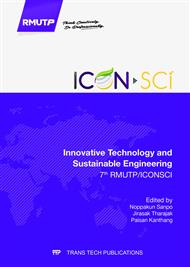[1]
C. Tendero, C. Tixier, P. Tristant, J. Desmaison, P. Leprince, Atmospheric pressure plasmas: A review, Spectrochimica Acta Part B: Atomic Spectroscopy. 61 (2006) 2-30.
DOI: 10.1016/j.sab.2005.10.003
Google Scholar
[2]
A. Bogaerts, E. Neyts, R. Gijbels, J. van der Mullen, Gas discharge plasmas and their applications, Spectrochimica Acta Part B: Atomic Spectroscopy. 57 (2002) 609-658.
DOI: 10.1016/s0584-8547(01)00406-2
Google Scholar
[3]
K. Suhem, N. Matan , M. Nisoa , N. Matan , Inhibition of Aspergillus flavus on agar media and brown rice cereal bars using cold atmospheric plasma treatment, International Journal of Food Microbiology. 161 (2013) 107-111.
DOI: 10.1016/j.ijfoodmicro.2012.12.002
Google Scholar
[4]
A. Schütze, J.Y. Jeong, S.E. Babayan, J. Park, G.S. Selwyn, R.F. Hicks, The Atmospheric-Pressure Plasma Jet: A Review and Comparison to Other Plasma Sources. 26 (1998) 1685-1693.
DOI: 10.1109/27.747887
Google Scholar
[5]
D. Ziuzina, S. Patil, P.J. Cullen, K.M. Keener, P. Bourke, Atmospheric cold plasma inactivation of Escherichia coli, Salmonella enterica serovar Typhimurium and Listeria monocytogenes inoculated on fresh produce, Food Microbiology 42 (2014).
DOI: 10.1016/j.fm.2014.02.007
Google Scholar
[6]
D. B. Aguirre, E. Wemlinger, P. Pedrow, G. Barbosa-Cánovas, M. Garcia-Perez, Effect of atmospheric pressure cold plasma (APCP) on the inactivation of Escherichia coli in fresh produce, Food Control 34 (2013) 149-157.
DOI: 10.1016/j.foodcont.2013.04.022
Google Scholar
[7]
R.X. Wang, W.F. Nian, H.Y. Wu, H.Q. Feng, K, Zhang, J. Zhang, W.D. Zhu, K.H. Becker, J. Fang, Atmospheric-pressure cold plasma treatment of contaminated fresh fruit and vegetable slices: inactivation and physiochemical properties evaluation, Eur. Phys. J. D 66 (2012).
DOI: 10.1140/epjd/e2012-30053-1
Google Scholar
[8]
A. Fröhling, J. Durek, J. Ehlbeck, J. Bolling, O. Schlüter, Indirect plasma treatment of fresh pork: Decontamination efficiency and effects on quality attributes, Innovative Food Science and Emerging Technologies 16 (2012) 381-390.
DOI: 10.1016/j.ifset.2012.09.001
Google Scholar
[9]
E. Noriega, G. Shama, A. Laca, M. Díaz, M.G. Kong, Cold atmospheric gas plasma disinfection of chicken meat and chicken skin contaminated with Listeria innocua, Food Microbiology 28 (2011) 1293-1300.
DOI: 10.1016/j.fm.2011.05.007
Google Scholar
[10]
H.P. Song, B. Kim, J.H. Choe, S. Jung, S.Y. Moon, W. Choe, C. Jo, Evaluation of atmospheric pressure plasma to improve the safety of sliced cheese and ham inoculated by 3-strain cocktail Listeria monocytogenes, Food Microbiology 26 (2009).
DOI: 10.1016/j.fm.2009.02.010
Google Scholar
[11]
S. K. Rød, F. Hansen, F. Leipold, S. Knøchel, Cold atmospheric pressure plasma treatment of ready-to-eat meat: Inactivation of Listeria innocua and changes in product quality, Food Microbiology 30 (2012) 233-238.
DOI: 10.1016/j.fm.2011.12.018
Google Scholar
[12]
G. Daeschlein, S. Scholz, T. von Woedtke, M. Niggemeier, E. Kindel. R. Brandenburg, K-D. Weltmann, M. Jünger, in Vitro Killing of Clinical Fungal Strains by Low-Temperature Atmospheric-Pressure Plasma Jet, IEEE Transitions on olasma science 39 (2011).
DOI: 10.1109/tps.2010.2063441
Google Scholar
[13]
N. Matan, M. Nisoa, N. Matan, T. Aewsiri, Effect of cold atmospheric plasma on antifungal activities of clove oil and eugenol against molds on areca palm (Areca catechu) left sheath, International Biodeterioration & Biodegradation 86 (2014).
DOI: 10.1016/j.ibiod.2013.08.025
Google Scholar
[14]
K. Suhem, N. Matan, M. Nisoa, N. Matan, In vitro and in vivo antifungal activities of various gas species under plasma jet treatment against brown rice cereal spoilage molds, International Food Research Journal 20(2) (2013) 947-951.
DOI: 10.1016/j.ijfoodmicro.2012.12.002
Google Scholar
[15]
P. Deeyai, P. Amnuaycheewa, P. Kerdtingmee, Effect of Atmospheric Pressure Argon Plasma Jet on the Growth of Bread Molds, Key Enginnering Materials 675-676 (2016) 744-748.
DOI: 10.4028/www.scientific.net/kem.675-676.744
Google Scholar
[16]
M. R. Abyaneh, M. S. Ghahfarokhi , M. B. Rezaee, K. Jaimand, S. Alinezhas, R. Saberi, T. Yoshinari, Chemical composition and antiaflatoxigenic activity of Carum carvi L., Thymus vulgaris and Citrus aurantifolia essential oils, Food Control 20 (2009).
DOI: 10.1016/j.foodcont.2008.12.007
Google Scholar


